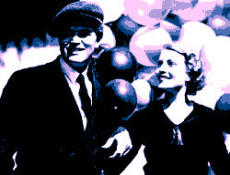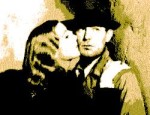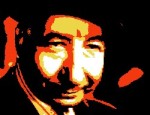Film Review
Sonnenstrahl (a.k.a.
Ray of Sunshine) exemplifies the
work of Pál Fejös, a Hungarian born filmmaker who, in the
1920s and '30s, was internationally well-regarded for his distinctive
brand of humanist cinema. Having made several films in his
native Hungary, Fejös emigrated to the United States where he
directed two of his best-known films,
Lonesome
(1928) and
Broadway
(1929). He returned to Europe in the 1930s and made films in a
number of countries, including France (where he directed the 1932
remake of
Fantômas).
In the mid-1930s, Fejös devoted himself to making documentaries as
he forged a new career for himself, as a dedicated anthropologist.
Sonnenstrahl was made in Austria, in two versions with the same
cast; the French version, titled
Gardez
le sourire, was co-directed with René Sti. The film
features two prominent actors of the period: Annabella, a star of
French cinema who had previously taken the lead role in Fejös's
Marie, légende hongroise
(1933); and Gustav Fröhlich, a popular German actor and filmmaker,
best known for playing the hero Freder Fredersen in Fritz Lang's
Metropolis
(1927). Annabella and Fröhlich both have a rare aptitude for
playing characters that are as fragile as they are tough and
resourceful, and so they are suitably paired in a film that plays on
these qualities. We can see that their characters are doing their
best to put on a brave face as they deal with the adversities that come
their way, but we also see the anxiety and desperation that are not too
far beneath the surface. Fejös emphasises the rapport
between the two characters by getting them to communicate mainly by
gestures, as in a silent film. There is hardly any
dialogue in the film, yet we seem not to notice that.
There are some striking similarities between Fejös's cinema and
that of his contemporary Frank Borzage. As in much of Borzage's
work,
Sonnenstrahl is a
heartfelt celebration of the resilience of the human spirit and the
redeeming power of love. It is a film which, despite its grim
Depression era setting and some horribly bleak moments, is relentlessly
optimistic. No matter what misfortune fate throws at the feet of
our two enterprising heroes, we know they will find a way through, that
the sun will soon come out from behind the clouds. (The
sequence in which the couple take their honeymoon in a travel agent's
shop is worthy of Chaplin.)
Made at a time
of extraordinary human suffering,
Sonnenstrahl
was a film that brought its own ray of sunshine. With its
exhilarating bursts of humour and poetry, it reminded audiences then,
as it does today, that life's challenges are ultimately what make life
worth living.
© James Travers 2012
The above content is owned by frenchfilms.org and must not be copied.
Film Synopsis
In the 1930s, Europe is caught in the grip of the Great Depression.
Across the entire continent ordinary men and women are struggling to support
themselves and their families in the face of an ever riding tide of unemployment.
In Vienna, Hans has decided that the struggle is no longer worth it.
He has lost his job as a taxi driver and now he sees there is no future for
himself. Penniless and hopeless, he is ready to throw himself into
the river when he sees a young woman about to perform the same desperate
act. Without a moment's hesitation, Hans comes to the woman's rescue
and does what he can to comfort her. She is Anna, an 18-year-old who,
like Hans, has given up the will to live. For his bravery, the city's
authorities reward Hans with a small sum of money, which he uses to buy some
soap to sell at a profit.
In this way, the young man soon has enough money to pay for a room for Anna,
although he is happy to go on sleeping on park benches. Their spirits restored,
the two young people take on an assortment of odd jobs and thereby raise
the deposit they need to buy themselves a concierge post. This job
requires them to be married, so they duly go ahead and tie the matrimonial
knot. This turns out to be another false hope, but the couple refuse
to be beaten. Hans soon has a steady income as a bank courier, and
within next to no time he has saved enough money to fulfil his dream of buying
his own taxi. Just when everything seems to have turned out for the
best disaster strikes. Hans' dreams of financial independence appear
to be cruelly shattered when he succumbs to a terrible accident...
© James Travers
The above content is owned by frenchfilms.org and must not be copied.



